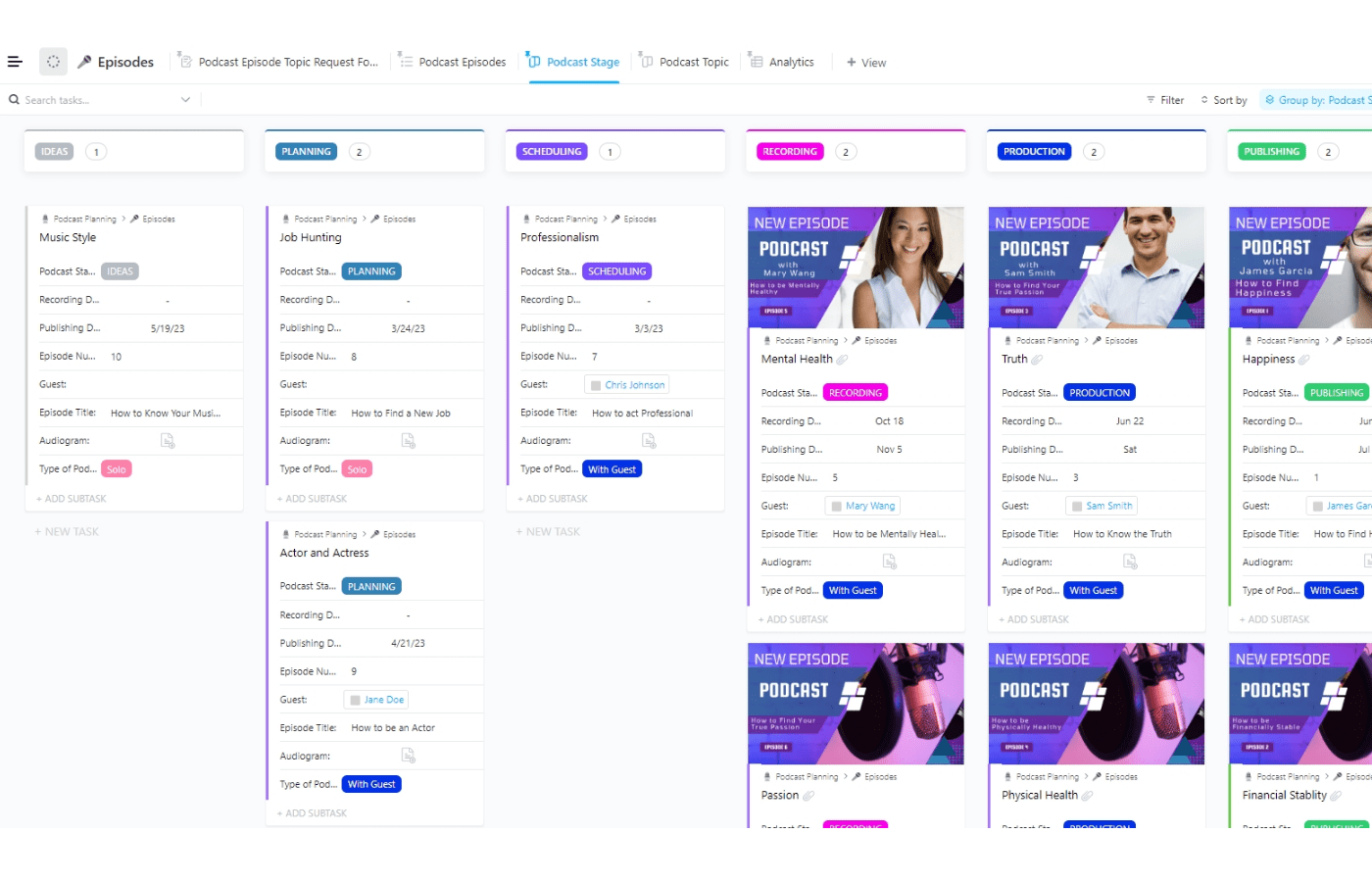Once your team has decided to make the shift from spreadsheets and Post-It notes to a formal project management software system, it can be a game changer for your organization. But first, you need to find the right fit. Read on to learn about the 10 criteria you should consider when choosing project management software.
READ MORE: What is Project Management?
10 Key Considerations When Choosing Project Management Software
| Factors to Consider: | What You Should Be Considering: |
|---|---|
| 1. Ease of Use How easy is it to navigate and use this software? | •How intuitive is this software’s interface? •How easy is this tool to learn and onboard? •What do user support options look like and how easily accessible are they? |
| 2. Task Assignments & Scheduling How easily can tasks be scheduled, assigned, and rearranged? | •How easily can I assign and schedule tasks? •How can deadlines be easily moved, if needed? •Can I assign multiple users to a task? |
| 3. Collaboration How easy is it for the team to share information? | •Can team members message each other? •What types of files can be shared within a workspace? •How will team members be notified about project updates and can those processes be automated? |
| 4. Customization Features How can individual teams customize this software to fit their unique needs? | •Are there specific template offerings or settings that can benefit specific users? (Ex: sales teams, technical teams, etc.) •Do API and other advanced customization options come built into this solution? •What project management methodologies does this solution support compared to the methodologies we use most often? (Agile, Waterfall, Scrum, etc.) |
| 5. Dashboards What type of data insights can be extracted across one or more project(s)? | •What are the most significant data points we would like to ideally extract from a dashboard view? •How far can data insights be broken down? By team? By individual user/team member? •How can data trends help us identify and predict potential issues? |
| 6. Project Views In what ways can you view projects and deadlines? | •What views are most important for our teams’ uses? •How easy is it to populate new views? •When certain views are limited by plan type, does our subscription include the views we need most? |
| 7. Integrations What other applications can be integrated with this solution? | •Which integrations are most crucial for our teams’ needs? •Are new integrations introduced over time? If so, how often? •Are the integrations connected directly or facilitated through a 3rd party, such as Zapier? |
| 8. Automation How can work actions be automated? | •Are automation actions limited to a set number per month or user? •Does this software offer automation shortcuts or templates? •How much time can we expect to spend setting up automations and maintaining them over time? |
| 9. Security What security features does this software offer? | •How can we limit and manage individual user settings and access? •How is security prioritized across desktop and mobile app usage? •How does this software provider manage or use our data? |
| 10. Unique Features What added selling points does this software offer that might be useful for specific team use cases? | •How do the needs of our team align with unique features within this solution? (Ex: time tracking for teams that work with freelancers, budgeting features for external clients, etc.) •How often are new features introduced and released? •Who is this specific solution best for? |
What Features Can I Expect in Project Management Software?
While individual features may vary from product to product, in general, project management software typically includes a few basic essentials:
Task tracking and project planning
Assign tasks, track schedules, deadlines, task dependencies, and review project status as it relates to overall project progress – promoting clearer team-wide expectations and accountability.

Collaboration features
Collaborate and communicate with team members across the organization at large, through commenting, tagging, messaging, and more – promoting transparency and helping organizations problem-solve faster.

Resource management
Resource management features enable teams to track team workloads, project budgets, freelance hours, client billables, invoices, and more – helping prevent budget overrun and promote proper resource allocation internally and externally.

Project dashboards and analytics
Monitor key statistics across multiple projects, while analytics power data-driven patterns and insights to help teams uncover trends and adjust accordingly.

Multiple project views
Project views give teams flexibility in how they choose to visualize project schedules and assignments.

READ MORE: Key Features of Project Management Software
Common Project Management Software Roadblock Tips
While getting ahead of the curve by researching and thoroughly vetting project management solutions can help maximize your chances of success when it comes to implementing a solution in your organization, there are still a few common pitfalls you should be aware of:
| Problem: | Solution: |
|---|---|
| Learning curve Naturally, certain project management solutions rank higher in terms of ease of use, but there’s an inherent learning curve associated with learning new software. | Give your team adequate time to adjust to the change and take advantage of solution-sponsored education and training opportunities whenever possible to help ease the growing pains of learning new software. |
| Poorly matched software solution Despite your best efforts to carefully select the best-fitting solution for your team, it, unfortunately, doesn’t guarantee that that software will be a good fit in practice. In some instances, once an organization has selected a solution, they find that it’s a poor fit or unable to scale alongside them in the long run. | Prioritize research and careful consideration throughout your selection process – and be sure to take advantage of free trials, demos, and even free plans to get an accurate feel of how a solution will react in practice. |
| Lack of support When it comes to customer support options, not all software solutions were built equally. One of the most significant complaints users have about project management software solutions is a lack of user support or long wait times for support. | When it comes to avoiding a support service disaster, research is your best friend. Read up on each solution’s support resources as well as what customers have said about those resources. |
| Difficulty integrating with the team & organization Unfortunately, when it comes time to integrate your new software solution with your team, even the best-laid plans can go awry. | If possible, designating a team member(s) as a well-trained go-to source for other colleagues during training and onboarding can help ease support woes. |
Read more: Remote Teams and App Development: Overcoming the Project Management Challenges
How to Get the Most Out of Your Project Management Software Solution
Investing in a new project management solution for your organization means a significant investment in time and financial resources. Here are a few of the top tips to get the most out of your new project management software solution:
- Prioritize finding the right fit for your organization: While it may sound redundant, the work you do before selecting a project management solution is crucial to your success in implementing it in practice.
- Consider a specialized solution. Certain project management solutions are designed to fit the needs of specific industries, either with industry-specific templates or features. For example, Jira is designed to fit the needs of technical teams, such as software developers. If your organization operates within a niche industry, consider a more specialized solution with features an templates to fit your unique needs over a more general one.
- Be clear about your plans to integrate the new solution into your team: Before you begin rolling out your new solution within your organization, you need to ensure that everyone is aware of the changes that will be taking place. Consider trialling the solution with a smaller group to test out your assumptions before announcing the implementation of a new system. Especially if your team has worked in one project management system for an extended period of time, your team will need time and hands-on experience with the new solution before your organization moves all production-level work over to the new system will help ease the transition while creating extra time to answer questions and create support systems as implementation begins.
- Use integrations whenever possible: Your shiny new project management software solution is likely chocked full of exciting features – but you can unlock more capabilities through integrations with other applications. Be sure to integrate your existing tech stack with your new software solution as much as possible and explore other integration options to expand the functionality of your solution. Pay special attention to how complex the integrations are to implement, and be aware of how those integrations may impact your existing workflows.
- Take advantage of free training and seminars: In order to make the most out of your software solution, you first need to understand how to use it to its full potential. Make sure you’re aware of the training and education resources available from your software vendor and take advantage of as many resources as possible to ensure you’re making the most out of the solutions functionality. Most paid plans provide extensive onboarding resources including videos, webinars, live and email support, and even customer success agents to help your team working at pace quickly and efficiently.
- Prioritize solutions that scale: Growth is inevitable. In order to prevent your organization from outgrowing your software solution, make sure to consider how each vendor can grow alongside your business over time, for example, by adding additional users, increasing file storage, the number of projects able to be hosted, and more.
When to Invest in Project Management Software
If you find that your team is relying on spreadsheets, scattered Post-It notes, and whiteboard scribbles to plan and execute projects, it might be time to consider investing in project management software. According to a survey published in PMI’s Pulse of the Profession report, organizations that invest in proven project management practices – such as project management software and project management roles – waste 28 times less money than organizations with poor project performance, according to the annual global survey of project management professionals, senior executives, and project management office directors.
With hundreds of vendors on the market today, offering plans that fit a wide variety of team needs and budgets (including free plans), there’s never been a better time to make the transition into a formal project management solution. Regardless of industry or use case, all organizations can consolidate files and project essentials in one place while streamlining work processes using project management software.
READ MORE: Best Project Management Software for Small Teams
What to Expect When You Begin Using a New Project Management Solution
There will be a short setup process involved for everyone who will be using the new system for the first time. Before you dive in, it can be helpful to understand what to expect. Typically, after users complete an initial set of questions about their intended use of the software and the number of collaborators, they are redirected to the home screen which typically includes links to specific projects, notifications, a personalized list of tasks, and more.

While specific layouts may vary, most project management solutions include a toolbar with quick access to project essentials, as well as a button or link for creating new projects. Within each project are a variety of view options, with some of the most common including board views, calendar views, and table views. In most software solutions, tasks can easily be dragged and dropped in any project view to easily alter deadlines. Dashboard views are also included, and typically highly customizable so that users can easily access project data and overviews across one or more projects.
It’s important to note that usability and user experience overall will vary across multiple solutions – making it crucial for you to examine an application’s usability and level of intuitiveness when vetting potential solutions.



READ MORE: Top Kanban Project Management Software Solutions
Where Do I Begin When Selecting Project Management Software?
Before you get to enjoy the perks of a new project management solution, you need to go through the process of selecting it. Here are the top considerations to keep in mind as you begin the process of choosing a project management software:
- Understand your team’s unique pain points
If you’re in the market for a new project management solution, it’s likely that your team has unique pain points when it comes to project management. Has your team struggled to keep projects on budget? Consider a solution with budgeting functionality built in. Worried about hitting key project milestones? Software with project progress tracking can help. The ideal project management solution should solve more problems than it creates for your organization.
- Define your budget and estimated number of users
Before you can properly identify your organization’s best-fitting project management solutions, you need to determine your budget and projected number of users. While most software vendors price subscriptions per user per month, pricing models can vary from free to $20+ per user/month. Establishing a clear estimate of total users and budget can easily narrow down your top vendor options.
- Consider the features that are most important to you
When choosing a project management application, you need to consider your team’s unique needs, use cases, and background. Is your team new to the world of project management software? Consider a more intuitive solution with excellent usability. Dealing with a highly technical software development team? Consider a solution with advanced functionality to support their needs. Every project management solution has its’ own flair and area of expertise, so considering how those features can align with your organizational needs is key.
Aaron Upright, co-founder of ZenHub, encourages teams to consider integrations when evaluating potential solutions. “Integrations should be a key consideration – the more integrated project management tools are with where the team already works, the higher the likelihood of successful adoption. For example, gravitating towards solutions that have a strong integration with familiar tools like Slack, Notion, or GitHub,” he said, “Having to learn a brand new interface can be daunting, especially for those teams that are onboarding into project management tools for the first time.”
- Research options
Once you have a foundational understanding of your team’s needs, it’s time to dive in. Take your time exploring the websites of multiple vendors, taking in the key features, pricing, and user reviews, in particular. Need help narrowing down your choices?
Check out our top 10 project management picks for 2023
- Demo a few top choices
Finally narrow down your selections to a few top software vendors. Now, it’s time to get testing. Most project management software solutions offer an industry-standard 14-day free trial – which gives you a great opportunity to test-drive numerous options before making a significant investment in time or resources.
How Can I Successfully Introduce Project Management Software Into My Organization?
Once you’ve settled on a software solution, it’s finally time to introduce it to your team – and that can be an intimidating topic.
Consider the three “T’s” for a smooth transition:
Testing
Before taking the plunge to ultimately settle on one solution, consider taking advantage of software demos and free trials with a few select team members, rather than one individual, to simulate how that solution specifically can integrate with your organization. Prioritizing hands-on experience early means you have a clearer picture of how your team will react to the new software.
Rae Foote, Project Manager at Visor, says “You always want to find that perfect balance between functionality and adaptability, understanding that out of the box, you’re looking to set things up as simply as possible to get from point A to B – with the ability to add-on and explore more complex features as time goes on.”
Training
Adequate training can ease learning-curve-related concerns and anxiety about adapting a new system. Beyond taking advantage of solution-sponsored training and resources, consider investing in an in or out-of-house training specialist who can work through potential hiccups and questions with your organization directly. Set realistic expectations when it comes to onboarding new software, designating anywhere from a few weeks to a few months to properly train staff.
Talking
The “talking” phase of implementing a new project management software solution involves direct communication with your team while prioritizing feedback, from the very beginning.
According to Foote, communication is key when onboarding a new solution with your team. “When your team is already a bit intimidated by the idea of learning a new solution, dialogue is key – not just someone at the top making a decision, or else you can add tension to the situation before they ever touch the software,” she says. “Explain the rationale behind the solution, they need to buy into your vision and workflow. The human aspect of choosing software is often lost. Collaboration is key because it’s a team effort – the less friction the more seamless the transition.”
Once you’ve begun working hands-on with the solution, continue to prioritize communication with your team. What struggles are they having when using the new software? What do they like? Are there any features they feel are missing? Any potential use cases to explore? Providing a space for open discussion can help team members feel more supported and comfortable as they learn and familiarize themselves with the solution.
Download Our FREE Guide of Top Considerations When Choosing Project Management Software
FAQs
Read Our Project Management Software Buyers’ Guides
Let’s be honest, selecting the right project management solution for your organization can be a daunting task – but don’t worry, we’re here to help.
Check out our selection of project management software buyers’ guides below:
10 Best Project Management Tools For Remote Teams 2023
Marketing Project Management Software Buyers’ Guide
8 Best Project Management Software for Architects
Best Project Management Software for Small Teams
Top 5 Agile Project Management Software Tools 2023
Best Construction Project Management Software 2023
10 Best Open Source Project Management Software for 2023
About Our Sources
Aaron Upright is co-founder & head of strategic accounts at Zenhub. Learn more about Zenhub here and connect with Aaron on Linkedin.
Rae Foote is an expert on all things Jira and a Project Manager at Visor. Learn more about Visor and connect with Rae on Linkedin.





